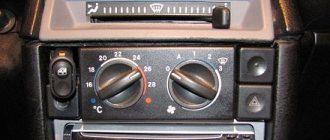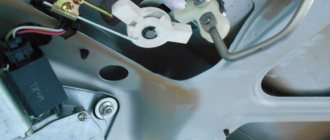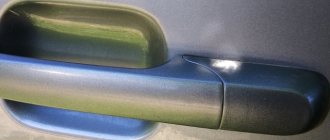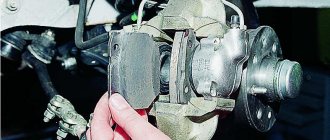A heating system that uses the heat of the coolant is responsible for heating the interior of the VAZ 2107. This scheme, recognized as optimal for cars with internal combustion engines, has been used in cars since the mid-20th century.
Like any car component, the VAZ 2107 stove may stop working. In winter, such a breakdown makes the car impossible to operate: the windows sweat or become covered with frost, which impairs visibility. For effective repairs, you need to have a good knowledge of the interior heating system.
Design and operation of the VAZ 2107 heating system
The system includes the following components:
- Heater VAZ 2107, whose task is to heat the air. The main element of the heater is the radiator, through which coolant circulates.
- A fan that directs heated air into the cabin. It is attached to the casing using elastic pads that dampen vibration.
- Heater control system, including a fan button, handles and dampers for the heating mode control system.
The heating system works like this:
Through the grilles on the hood, air enters the air supply box located in the engine compartment near the windshield.
In the event of rain or downpour, the water is separated from the air and flows into the holes in the box. This allows you to use the stove in any weather, but until the radiator heats up, the air entering the cabin during rain will be damp.
The air flow is directed to the VAZ 2107 heater and heats up as it passes through the radiator. Heating is regulated using a tap, which regulates the amount of coolant passing through. The crane is controlled by a flexible rod attached to the control lever.
While driving, the air flow enters the engine compartment and the air independently enters the heater. When stopping or at low speed, an electric fan is used, controlled by a switch that has three positions: “off”, “full speed” and “low speed”. Reduced speed is achieved by turning on the electric motor through a resistor, which reduces the voltage on the motor winding.
After the radiator, the air enters the air ducts and exits through deflectors, which allow you to change the direction of flow. Warm air can be directed onto the windshield and side windows, under the feet of the driver and front passenger.
Control elements of the air flow from the VAZ 2107 stove:
- Fan air distribution cover that regulates air flow.
- Levers and handles that change the position of the air supply covers and dampers that regulate airflow.
Before repairing the VAZ 2107 stove, it is necessary to understand the causes of the malfunction.
Let's sum it up
Timely diagnostics, preventive cleaning and inspection of elements of the vehicle’s heating system is a guarantee of high-quality operation of the stove. Experts recommend checking the heating system on the VAZ-2107 at least twice a year - in autumn and spring. Any driver can handle preventive cleaning and adjustments of the stove on his own; to do this, you just need to understand the structure of the heating and ventilation system of the cabin and the principle of its operation. The easiest way to do this is to always have a visual instruction manual for your car nearby.
Don’t put off any further work to improve the functioning of your car’s heating system. Proper care will ensure uninterrupted operation of the heater and a comfortable temperature in the interior at any time of the year.
Malfunctions of the VAZ 2107 stove and how to eliminate them
If the VAZ 2107 stove does not heat up and when the heater is on, the air leaving the deflectors remains cold, the reasons may be as follows:
- Airing the cooling system. This can happen when replacing antifreeze or repairing cooling system components. To restore heating, you need to remove the air plug.
- The heater valve in the open position continues to shut off the line. The reason for this is a clogged faucet or the formation of scale in it due to the use of water in the system instead of antifreeze. To restore the heater's functionality, the tap must be removed and then cleaned or replaced with a new one.
- The stove remains cold when the tap is open. The cause of this phenomenon may be a non-working pump. This breakdown quickly makes itself known through rapid overheating of the engine; it is impossible not to notice it. If the engine is warmed up to operating temperature, and the pipes leading to the VAZ 2107 heater remain cold, the pump needs to be repaired. One of the reasons why the pump will not work is a slipping or broken alternator belt.
- The air is cold and the supply hose is hot. This is a common problem resulting from clogged radiator honeycombs. They can become clogged due to scale build-up, oil in the antifreeze, or the use of “leak stop additives.” In this case, the VAZ 2107 stove must be dismantled and washed.
- The radiator pipes are hot and the air is cold. This occurs when a baffle in the radiator moves and creates a straight path between the inlet and drain pipes. You can restore functionality by replacing the radiator.
Another type of breakdown is an antifreeze leak. This manifests itself in the appearance of condensation on the windows or leakage of antifreeze into the passenger compartment under the feet of the passenger and driver. The reasons here are:
- Antifreeze is leaking through the heater valve. In this case, it can be replaced without removing the radiator.
- The leak occurs through a burst pipe. The solution is to replace the pipe with a new one.
- The heater radiator is leaking. In this case, repairing the VAZ 2107 stove involves soldering or replacing the radiator.
If there is a leak of antifreeze due to a breakdown of the heater, repairs must be carried out immediately - the ethylene glycol contained in antifreeze is toxic and inhaling its vapors causes serious harm to the body.
Refinement using a new snail
To radically change the airflow of the stove and make it quieter, you can install a snail from the VAZ-2108 on the VAZ-2101.
What to buy
To do this you will need:
- New airflow mode switch.
- Resistance from a VAZ-2108 car.
- Snail from VAZ-2108.
- Wires, bolts, nuts, aluminum or any other corners.
- Thick plexiglass for the box.
- Industrial hair dryer to bend plexiglass.
Work step by step
As a result, we will get an improvement in all heating indicators - the cabin will be warm, and the most pleasant thing is that the noise will be significantly reduced.
- We make a housing for attaching the “snail” from plexiglass. That is, we cut it, bend it with a hair dryer, getting the desired shape. To reduce the size of the case, you can cut off the snail plugs.
- The side walls can be made of duralumin (1.5 mm thick). If cracks or crevices appear in the joints during work, they should be sealed with silicone sealant.
- We make collapsible air channels through which the flow will go to the air duct openings.
- Turns must be made smoothly to reduce air resistance in the flow and direct the air straight.
- If you want to bring airflow to your feet, make slots with flaps in the right places. If desired, you can install a variable resistor for adjusting the speed of the cochlea instead of the backlight brightness resistor.
If you do everything correctly, you will get a stove that operates almost silently, especially at low speeds. Despite the large number of bends in the design, the air flows will be sufficient to quickly heat the interior, and the second and third speeds can be turned on only in emergency cases - when you need to heat the interior very quickly.
Therefore, if you are not satisfied with something in the VAZ heating system, try to modify it. And you will succeed!
Dismantling the heating radiator VAZ 2107
To do the job you need a Phillips screwdriver and a set of wrenches (open-end and socket).
Sequence of operations:
- loosen the heater hose clamps located in the engine compartment;
- remove the hoses from the heater radiator pipes (this may result in a slight leak of antifreeze);
- unscrew the screws securing the rubber seal;
- remove the seal;
- unscrew the radio panel;
- disconnect the cable from the tap of the VAZ 2107 stove;
- Using a screwdriver, remove the brackets on the fan casing;
- lower the casing down;
- remove the heater radiator.
How to identify the problem and fix it
There are several reasons why the furnace blows cold air or does not work at all. In this case, you must proceed as follows:
- Check the faucet to see if it opens.
- Is the cold air damper capable of closing?
- With the car running, check the heater (heater radiator) for heating.
Radiator replacement
If the problem is in the radiator and it needs to be replaced, then proceed as follows:
- Drain the liquid.
- We unscrew the two clamps from the engine compartment, which are located on the radiator pipes. We remove the hoses.
- Unscrew and remove the fasteners on the rubber seal.
- We dismantle the radio panel and the cable fasteners on the heater valve drive. To do this job you will need a 7 key.
- Next, use a screwdriver to remove 4 spring clips from the fan casing. The casing drops down and slides to the left, after which the radiator can be pulled out.
- Now you can carefully examine the radiator, revive it or replace it with a new one. Assembly is carried out in the reverse order and does not involve any difficulties.
A broken radiator is a common cause of a non-functioning stove.
Restoring glass blowing
The stove that is installed on the VAZ-2107 has some design features, due to which the left pipe often does not blow the glass well enough. To put up with such an inconvenience in winter is difficult. Therefore, it is worth working to eliminate this problem. You must proceed according to the following scheme:
- We remove the deflector from the pipe by prying one of its sides with a screwdriver.
- The deflector body is held on the torpedo using small antennae. We put our hand inside and pull it out.
- The 50mm fan from the computer must be placed in the center of the dismantled case and marked in the appropriate places.
- In the plastic case, using a utility knife, hacksaw or sharp knife, cuts are made at the marks.
- The plastic easily breaks off along the line of cuts and an opening is obtained into which the fan is installed. It should fit snugly in place.
- We return the insides of the deflector to their place. The internal blades will not be able to rotate at full speed due to the changes made.
Other minor faults
Finding and fixing minor problems on your own is a handy skill for any car enthusiast.
After such actions it will be easy to determine the causes of the breakdown. And they can be as follows:
- If the faucet is working properly, but the heater heats up only at high engine speeds and under such conditions begins to blow warm air, then the fault should be looked for in the pump or a coolant leak. To find a leak, you must carefully examine the required area of the cabin. If leaks are found, the hoses need to be replaced, tightened or new clamps installed. Do not neglect the cap on the expansion tank. Tightness is the main condition under which the heater can function normally.
- Leaks can also occur due to rusting of the radiator, taps and other elements of the heating system. In this case, it is enough to simply replace the necessary part and enjoy a comfortable ride.
- The tightness can be checked in another simple way. Turn on the engine and wait 10 minutes. During this time, the expansion tank should warm up. If this does not happen, then we can talk about the lack of pressure that is necessary to supply antifreeze or antifreeze to the heater stove.
- If you notice that the car gets very hot when standing in a traffic jam, then you can talk about the lack of necessary pressure.
- The stove can become clogged with various debris and become coated from the inside with oxides of various substances. In this case, it is necessary to clean out the debris and clean the system.
The car owner must be prepared for minor problems and be able to quickly fix them. For example, with the onset of winter, many VAZ-2107 owners’ stoves do not heat up and it is not always convenient to run to specialists with this problem.
Repair of heating radiator VAZ 2107
Often, repairing a VAZ 2107 stove involves replacing or repairing the heater radiator. Repair actions depend on the type and cause of the malfunction:
A clogged radiator can be flushed with water pressure. Scale on the walls of honeycombs can be removed using a special product that dissolves it.
A leak in a copper (brass) radiator can be soldered. Using a powerful soldering iron and solder, you can repair a hole or crack. Leaking aluminum radiators must be replaced.
Important: to eliminate a leak in the heater radiator or engine cooling system, you should not use products added to antifreeze - they can cause clogging of the VAZ 2107 radiator honeycomb.
Control mechanism
The control of the VAZ 2107 stove is mechanical. It consists of a fan switch and a block of sliders. The control mechanism is installed on the center console at the top, which provides easy access to the elements.
There are three sliders of the control mechanism, and each of them controls its own element:
- The top one is responsible for supplying antifreeze to the radiator and is connected by a cable to a tap installed on the inlet pipe. The extreme left position of the slider means the tap is closed (the stove does not heat), the right position means the tap is open (antifreeze enters the radiator).
- Middle – air supply damper control. When you move it to the left, the damper shuts off the air supply from the street (closed air circulation in the cabin), while the right position means the air flow is open (air from the street enters the cabin).
- The lower one controls the damper for distributing the flow through the air ducts. Left position - the flow is supplied through the side and central deflectors, right - to the windshield area. Each of these sliders can be adjusted to any position to achieve optimal stove operation.
Heater assembly VAZ 2107
The repair of the VAZ 2107 stove is completed by assembling the heater. They assemble it in the reverse order of disassembly. The work has a number of features:
- rubber gaskets must be replaced with new ones and lubricated with silicone sealant;
- before assembling the heater, it is necessary to attach the pipes and tap to the radiator;
- Do not overtighten the nuts so as not to crush the gaskets;
- before putting on the rubber hoses, the outer surface of the metal radiator pipes must be treated with sealant;
- After the VAZ 2107 heater is assembled and connected, you must remember to add antifreeze to the system and check its tightness.
Important: repair of the VAZ 2107 stove must be carried out in conjunction with checking the serviceability of the engine cooling system components. This approach allows you to accurately determine the cause of the breakdown and reliably eliminate it.
Reasons for replacement
Replacing the VAZ-2107 stove motor occurs for several reasons. Let's look at the most common cases when a new VAZ-2107 heater fan is needed.
- A terrible sound with a characteristic screeching sound. If such a squeal appears when the car is warming up, it is better not to lubricate the engine, as many do, but to replace the VAZ-2107 heater fan.
- The air does not flow and the interior does not warm up - there is nothing left to do but remove and change the heater motor on the VAZ-2107.
- The air flow is very weak.
- The interior warms up extremely slowly.
Remember that a well-functioning system will be almost inaudible, since insulation and other materials ideally muffle sound very well. However, if something is broken, you can easily fix it.
In rare cases, VAZ 2107 owners need to replace the heater fan. Unlike other models, the VAZ 2107 has a more extensive blowing system, therefore, replacing the fan motor is somewhat more complicated. But don’t despair; complicated doesn’t mean impossible. Simply replacing it will require a few additional movements, that’s all.
Completing this task will require a minimum of tools and equipment:
- Key to 7;
- Key for 10;
- Flat screwdriver;
- Phillips screwdriver;
- Round nose pliers.
To begin work, it is necessary to remove the instrument panel of the VAZ 2107. Without this, it is not possible to gain access to the heater fan housing. Next, the shelf and glove box will be removed. The preparatory activities have been completed, you can proceed to the main task.
Using a 7 key, release the casing of the cable for controlling the air dampers of the stove, and remove the cable loop from the lever.
Using a 10mm wrench, unscrew the nut securing the heater housing and the right and left air ducts. Using a flat-head screwdriver, very carefully remove both air ducts from the stove body.
If one of the elements of the blowing system is damaged, they should be repaired or replaced immediately. Using the same screwdriver, remove the latches that hold the fan on the heater radiator.
Now you can remove the fan from the heater housing, after first disconnecting the wire terminals from the resistor. To replace the motor, you must first remove the impeller. To do this, use round pliers to remove the retaining ring and adjusting washers. The impeller is now held on the shaft only due to a tight fit. We carefully remove it, trying not to damage the blades, because replacing the impeller was not planned.
Use a flat-head screwdriver or pliers to remove the spring plates holding the fan in the housing.
You can remove it by first threading the power wires through the holes. Usually, if the fan motor is faulty, simply replace it with a new one.
In rare cases, it may be necessary to disassemble it, for example, to clean the commutator or lubricate dry bearings.
Installation of a new engine is carried out in the reverse order, as is the assembly of the fan, heater housing, and air duct system. Before installing the fan, it is recommended to check its functionality by connecting it directly to the on-board network of the VAZ 2107. This will help avoid unnecessary work in case there was an error in the connection diagram or you received a defective (non-working) fan.
When disassembled, access to the heater radiator and valve of the VAZ 2107 is available. You should take the opportunity to inspect and diagnose them for damage, leaks, and signs of possible failure of the valve. This will help avoid unnecessary work, such as removing the instrument panel, disassembling and assembling the stove body, etc. If problems are detected with the radiator or faucet, they are also replaced.
Design
The design of the VAZ 2105 and 2107 stoves is absolutely the same. And they consist of the following elements:
- Radiator;
- faucet;
- Holes for airflow of legs and interior;
- Stove motor;
- Radiator pipes;
- Gaskets;
- Protective cover.
In case of any breakdown associated with this mechanism, you will definitely have to remove the heater radiator. Since the cause of the breakdown mainly lies in it, for example, a coolant leak, clogged pipes, etc. But sometimes it’s not enough to just clean a part; sometimes you have to replace it. Let's look at how to do this now.
How to replace a fan with a more powerful one (in detail)
Work order:
- Remove the lower part of the stove - the casing on which a regular fan is mounted.
- Remove the standard electric fan completely as it will no longer be needed.
- Carefully cut off one of the aerodynamic ridges that supply air to the legs of the passenger and driver, since the motor from the V8 is much longer.
- Next, the impeller is removed, and all functions fall on a standard five-bladed fan.
- The hole in the impeller needs to be slightly enlarged in diameter and the new shaft carefully inserted into it. Make sure that the new structure fits securely into place.
- Before installing a new fan, connect it directly and check its functionality.
- Replace the built-in resistor, the main task of which is to ensure relatively quiet operation of the fan. As a result of the large volume of air being transferred, the new fan will create a lot of noise. The best replacement option would be a resistor installed on the figure eight.
- Replace the fan switch with a similar one from model 2108. The reason is that when the heater operates for a long time, a completely different current will be supplied, which is why after some time the standard power button will simply melt.
Nozzles
A nozzle, or deflector, is a device through which air enters directly into the cabin. The heating system of the VAZ-2107 includes four deflectors: left, two central and right. A special feature of the nozzle design is a mechanism that allows you to change the position of the lamellas inside it, redirecting the air flow from side to side, and also block it altogether.
Muffler tuning
The exhaust system of VAZ cars of the “classic” series (2101–2107) consists of three parts: the exhaust pipe (“pants”), a resonator and a muffler.
Direct-flow muffler: device, advantages, installation
Many owners of “kopecks” do not leave the exhaust system of their cars without improvements, replacing the standard muffler with a direct-flow muffler, or simply adding it to an existing one, achieving the “double exhaust” effect and the characteristic low roar that accompanies it.
What is the difference between a straight-through muffler and a regular muffler? A standard muffler consists of numerous sharply curved baffles and tubes. Passing through them, exhaust gases are forced to change directions, which is why the pressure drops, the sound becomes quieter, and toxicity decreases.
In a direct-flow muffler, the pipes, as the name suggests, are straight, the bends are smoothed, there are no partitions, and there are fewer welds. This allows exhaust gases to move freely.
In a direct-flow muffler, exhaust gases encounter almost no resistance on their way out, which means they do not lose pressure, etc.
A ready-made ramjet engine can be purchased at a spare parts store; This pleasure will cost one and a half to three thousand rubles. Most models can be installed without welding. However, some craftsmen make direct-flow mufflers on their own, using old undamaged mufflers and pipes, or limiting themselves to only the latter.











